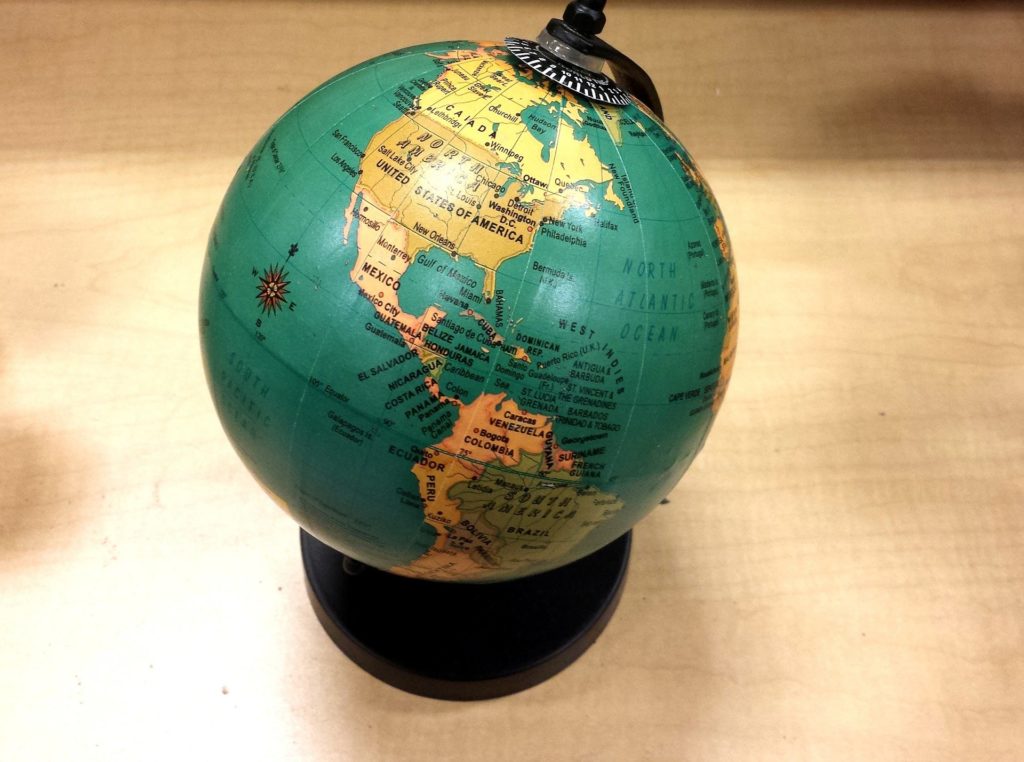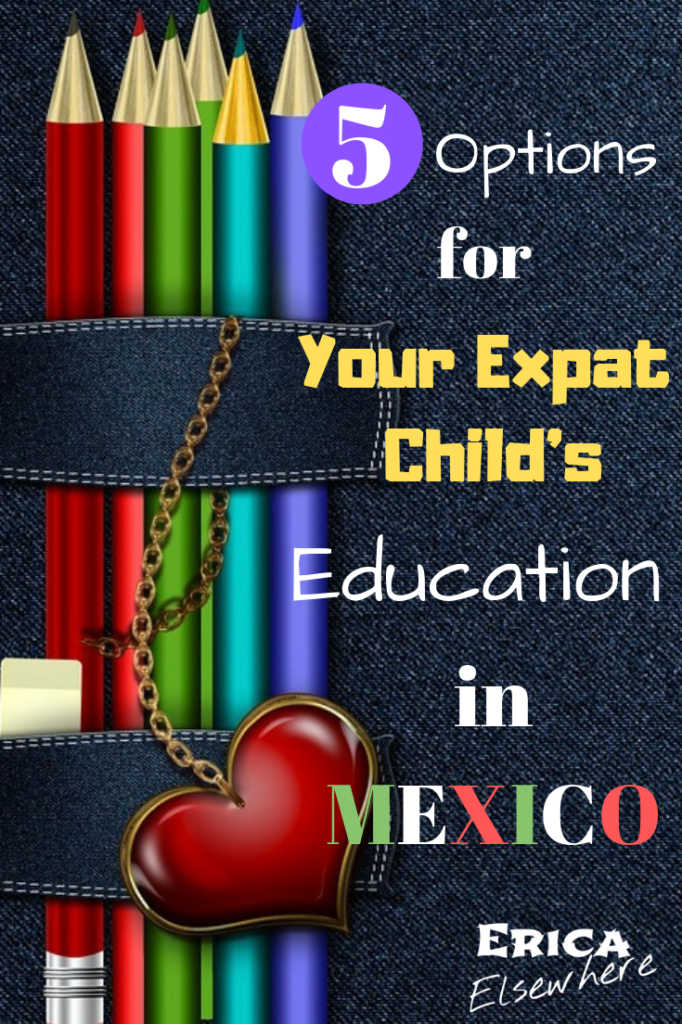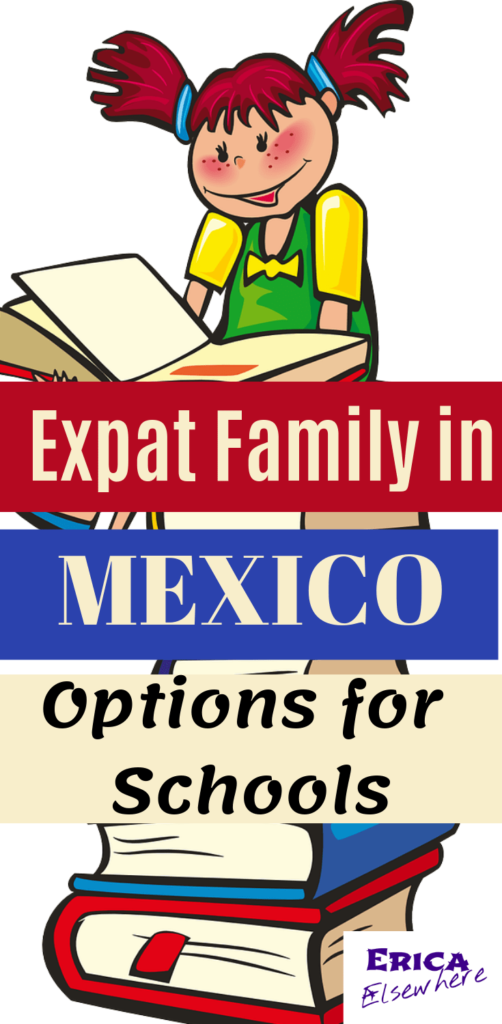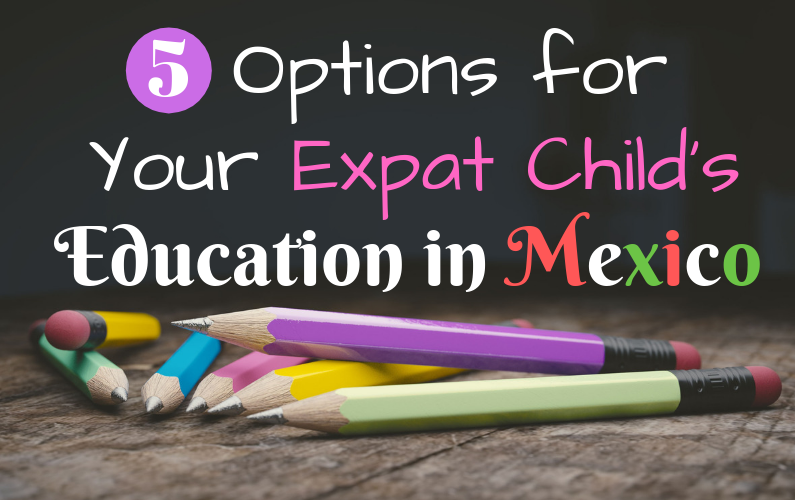Our daughter was 10 months old when we flew her from our Kentucky home to Mexico over 5 years ago. With her being so little and with so many other life altering subjects to ponder on, creating a plan for her future schooling did not make it on the top 10 priority list in my frazzled brain. But she grew, as children do, and by the time she was 2, I began to think about her education in Mexico.
I discovered that there are really 5 options for basic (primary and secondary) education in Mexico.
- Public schools
- Private Schools
- International Schools
- Homeschooling by designing your own curriculum
- Homeschooling through an accredited foreign school
It’s easy to list those out now, but it was years before I was aware of or had in-depth knowledge of each of those options.
I was surprised to learn that in Mexico there are 3 years of preescolar or kinder (preschool/kindergarten) and therefore, school begins at 3 years old. In the United States, those first two years are what we would call preschool and the third year is the equivalent of our kindergarten.
I had never planned on sending my daughter to preschool, not even in the United States, so I was a bit stunned by these seemingly compulsory two years of preschool built into the school system itself. My concept had always been that she would start school at 5 years old in kindergarten. The idea of letting her go any earlier, and in a foreign country at that, was…well, rather traumatizing.
Keep in mind that by this time, while I had obtained permanent residency in Mexico, my daughter had actually become a dual citizen. I believe this fact deepened my desire to conform to local laws regarding education in Mexico, as opposed to if she were only a resident.
Still, she was only 2, so once again, I pushed the idea to the back of my mind and went about life. But when she was well into her 3s I figured I may as well look into the situation further, determine if all of those years of preschool were obligatory, and figure out what my options were.
The fact of the matter was that there were areas of the country that didn’t even have all 3 years of preschool available. Where we lived in Cabo San Lucas, that first year of preschool didn’t exist. So only levels 2 and 3 were options for parents. I wasn’t sure how something could be required when it wasn’t even available in all areas.
The information that I found was a bit conflicting. But overall, I got the impression that while all 3 years appear to be extremely highly recommended by Mexico’s education administration, SEP (Secretaría de Educación Publica), really only the final year is mandatory.
But now that we were in Chiapas, all 3 levels appeared to be the norm. I began to ask around the community and got mixed responses. I heard everything from, “I’m waiting until my child is 4 years old. 3 is too small” to “Oh, yes, she should already be registered since she turned 3 in January.” The latter came from a professor in a local school, so no surprise there.
My biggest question was what could she possibly learn in that first, or even second year of preschool that she didn’t already know or that I couldn’t teacher her at home? She knew her colors and shapes and vowels and numbers beyond 10…in two languages. Her vocabulary was extensive for such a little peapod and she had been having intelligent conversations with adults since she was 2…in both languages.
At the end of the day, we realized that nothing bad was actually going to happen if we waited an extra year to send our little one to school. I was certain that they wouldn’t flat out reject her in the second year of preschool just because she hadn’t completed the first. And it was going to be very hard to let her go. She was just a baby. But there was a problem…
She REALLY wanted to go to school. She would ask us constantly when she was going to start school. She would see the other kids in their little uniforms heading off to school in the mornings and wanted to go with them. She enjoyed being with other children, as children usually do, and wondered when it would be her turn.
So I began to dive even further into our options for preschool, primary, and secondary education in Mexico (we’ll leave high school and college for another day as grades 10-12 are not part of Mexico’s basic education system). This is what I found.

1. Public Schools

I was aware that Mexico had both a public and a private schooling system for preescolar (preschool/kindergarten), primaria (elementary school grades 1-6), and secundaria (middle school grades 7-9). These form the basis of basic education in Mexico.
This government page in Spanish provides information on these three levels and what is expected to be learned in each: https://www.mexterior.sep.gob.mx/sisedMEX.html
But my knowledge of the difference between public and private ended with the obvious – one is free and one is paid.
Public school is free, although parents usually cover costs for such things as supplies and uniforms. Many of our friends had their children in public school and no one complained of anything detrimental going on within them. They didn’t report feeling like their children were unsafe, and safety was our #1 priority.
I found some expat families online saying that they preferred to send their children to public schools because they were guaranteed to learn Spanish since English is not an option.
Our daughter was already bilingual, being raised in a bilingual household. But still, our initial thought was why not send her to public school for these 3 years of preschool/kindergarten because why pay for her to “learn” some basic things that she already knows. Then we’ll send her to private school beginning in primaria.
So my husband began the task of investigating some public schools around the area. We started at one that is extremely close (and I’m talking, walk out the door and take about 15 steps close) that is dedicated only to the three years of preschool/kindergarten . That sounded nice because she wouldn’t be with any big kids.
But the staff had a bit of an attitude about some basic inquiries that my husband had. So he nicely thanked them for their time and that option went bye-bye.
Another public school seemed OK but they were at capacity. After all, we were supposed to have begun the enrollment process in February (we didn’t know!) and it was now June. At a third public school they still had some room and were friendlier than the first, but by that time, I had found out some things about public schools in Mexico that I wasn’t fond of.
Between interviewing our friends, speaking to our neighbor, who was a professor, and tons of internet research from Spanish blogs and websites, we discovered that class sizes in public schools in Mexico are large with 25 or 30 students per class. The maximum approved number of students per class is in constant debate. In 2016, the approved maximum was set to 30 students, at least in some states, but schools were given 5 years to put that into effect, so some classes are still larger than 30 to this day. Further changes in regulations may have taken place since then.
We also came to find out that there are many public schools that lack basic equipment and even proper bathrooms.
Problems such as bullying and distracting behavioral problems were reportedly much more common in public schools.
Perhaps most surprising to me, we were told that the qualifications of the teachers can be hit or miss in public schools in Mexico. There are definitely good ones teaching in public schools. But there are others who don’t truly meet the minimum qualification requirements or who have gone so far as to “purchase” their titles.
While the public schools that we visited appeared to be in good physical shape and I had never come across any local school in the deplorable state of some of the pictures that we’d seen on the web, the parts about large class sizes, excessive distractions from bad student behavior, and questionable teacher qualifications in public schools were confirmed and double confirmed by our friends and neighbors.
Knowing this information, we were no longer keen on attempting to find a “good” public school within the city. We turned to looking at private options for education in Mexico.
2. Private Schools

What are the advantages of private schools over public? Here are a few:
- Better security (hands down, the most important point for us on this list. You could eliminate all the other bullet points and we still would have gone the private route based on this alone)
- Smaller class sizes. Information on averages are hard to come by, but class size for my daughter’s last 2 years of preschool/kindergarten have ranged from 13-15 students. Some of our friends who have children in private schools report similar numbers
- Teaching of the English language. All private schools that I’ve come across in Mexico teach English, or at least attempt to do so, although the quality and methods of teaching will vary greatly between institutions and between cities and states. I have not yet come across any native English-speaking teachers in San Cristobal de las Casas in the primary and secondary levels of education
- Teachers who possess the proper degrees and qualifications for their positions
- Superior installations and equipment
- More activities, events, and field trips. Being that the parents are paying for everything, there is obviously a much greater opportunity for special events.
- Students who are better behaved
That being said, careful research will be necessary for each and every school that a parent is considering as they vary a LOT from school to school, city to city, and state to state!
We were extremely fortunate in that the very first private school that we visited (it came via a friend’s recommendation) was a winner in our book. And it didn’t hurt that it was a 5-minute walk from our house.
We were greeted by the preschool director who probably spent an hour with us, touring us all around the school, introducing us to other teachers, showing us everything that is involved in a day of preschool, and answering our questions. We took our daughter with us (3-years-old at the time), who immediately began to play with the other kids on the playground, and was not bothered by their friendly oohs and aahs over her pelo colochito bonito (pretty curly hair).
We were impressed. We signed her up that day and have had, overall, a very positive experience since then. The teachers and directive personnel have done well with communicating with us and also being respectful of our religious beliefs in making sure that school activities don’t interfere with them.
The school has preschool, primary, and secondary levels in the same school. This concerned us a bit at first, but the older kids have their own areas and staggered schedules from the smaller ones. We haven’t had any issues.
We know 5 other children from friends of ours in the same school. They are all in different grades and their parents have all have reported positive experiences. The curriculum seems up to par, although the other children would benefit from more of an English language immersion environment, rather than just one English class from a non-native teacher.
Let’s talk about the cost of private school in Mexico. As you can imagine, the prices vary dramatically depending on your location. According to the aseguratusmetas Spanish blog, the tuition costs of private education for primaria and secundaria schools can range from $33,264.00 MXN – $132,853.00 MXN per year. With the current approximately 19/1 MXN/USD exchange rate, that’s the equivalent of about $1,750 – $6,992 USD per year.
Preschool/kindergarten is not mentioned in the figures above, but to give you an idea, preschool ran us about $21,000 – $27,500 MXN in tuition per year ($1,105 – $1,447 USD). It goes up every year. First grade would cost us a bit over $35,000 MXN ($1,860 USD) in tuition and registration fees. Of course, there are books, materials, uniforms, and various other costs to take into consideration.
It should be noted that the higher priced schools are almost exclusively within Mexico City or other major cities. In a state like Chiapas, with a low cost of living, private education can be found on the very low end of that spectrum. And also, in a state like Chiapas, you must be even more selective in your search. But do not dismiss them as places in which good educational options do not exist.
Our daughter had a great three years in this private school and we don’t regret our decision at all. As a whole, we consider private schools one of the best options for expat children’s education in Mexico, while still being affordable.
Again, as you would do with any school in any country, do your thorough research before enrolling your child. Definitely check online to see what kind of reputation the school has, but don’t rely on this information alone. The school atmosphere can only be observed in person.
Visit the school and talk to the staff. Observe the students, if you are allowed to. Ask to see the books and the curriculum. Visit several schools so that you have many points of comparison.
3. International Schools

Depending on your city (and especially if you live in Mexico City, Guadalajara, or Monterrey) you can find private schools that fall within still another subcategory – international schools. Some international schools primarily teach in English, others in Spanish, and many others are bilingual.
The bilingual schools may be very interesting options for education in Mexico for expat families since all classes from K-12 are taught in both English and Spanish. Bilingualism is expected upon graduation and children can graduate with the International Baccalaureate (IB) diploma, opening the door to worldwide opportunities.
In some schools, an American diploma, Mexican diploma, and the IB are given upon graduation. You can find a list of Mexico’s international schools on this page: https://www.internationalschoolsearch.com/international-schools-in-m-xico
International schools are said to have a global focus, helping students to obtain cultural awareness and think more independently. The programs prepare students for entry into an increasingly globalized market. Students of schools with International Baccalaureate programs often outperform their peers academically. You can find more information about IB programs here: https://www.ibo.org/
International schools are pricey. This website of Mexico’s top international schools shows few that offer tuition costs less than 70,000 pesos ($3,684 USD) per year and the top school costing over $240,000 pesos ($12,362 USD) per year.
This is, by far, the most expensive option for education in Mexico.

An Overview of Homeschooling
Our last two educational methods will cover homeschooling. You’ll soon see why we’ve divided these into two categories.
First, an overview:
Homeschooling is becoming increasingly popular in many countries. The United States, Canada, and the UK have the largest percentage of homeschoolers. However, there are some countries that have forbidden it outright (such as Germany and Brazil).
What about Mexico?
Mexico’s laws do not specifically mention/approve homeschool, however, they also do not forbid it. Therefore, it is considered legal to homeschool in Mexico.
The Home School Leading Defense Associate (HSLDA), who has been leading the way in the defense of homeschool worldwide for many years, says this: “Legal Status: Without clear compulsory attendance laws, homeschooling is flourishing legally. As a general rule Mexican families homeschool without significant interference from the government.”
In recent years, several other organizations have come on to the scene to defend and educate parents about homeschooling specifically in Mexico. Supraescolar has written an interesting article, which you can find in Spanish, at https://supraescolar.com/2018/04/16/que-tan-legal-es-la-educacion-en-casa-homeschooling/, which goes into detail about the legality of homeschool as an option for education in Mexico.
For parents interested in this option, it helps to have these leaders on the forefront looking out for changing laws and educational reforms, while keeping the rest of us informed with respects to homeschool in Mexico.
But let’s be honest for a moment. There are thousands of children in the streets in Mexico working instead of going to school, and not even the majority of these families ever receive government interference for not sending their children to school. Therefore, maintaining a structured (or even a delightfully unstructured) homeschool plan is very unlikely to experience resistance in Mexico, at least for the time being.
And at the end of the day, expats will almost surely receive fewer eyebrow raises in doing so than nationals, regardless of which homeschooling method they choose.
Homeschooling has been shown to have numerous benefits for children.
- Parents can tailor the studies to their child’s unique interests, learning styles, abilities, and talents
- Due to the personalized curriculum and one-on-one attention, homeschooled children often excel above their peers academically
- There is freedom to pick and choose amongst the wealth of resources available (books, online courses, hands-on activities) without having to stick to one particular curriculum
- Children who excel in a certain subject are not confined to the subject material of their particular grade. They can advance more rapidly and even graduate early.
- Difficult material for your child can be reviewed as many times as needed without the need to adhere to a specific time table.
- Some children learn better in an environment free from pressure and with less distractions
- There is flexibility in scheduling. Travels and family activities no longer need to be planned around a rigid school schedule. Rather, school can be planned around these other activities.
- Parents create strong bonds with their children.
- If school violence, crime in the local area, or bullying are concerns, homeschooling can provide a measure of protection.
As a former homeschooler myself through part of my grade school years, I can attest to many of these benefits. Homeschooling allowed me time to dedicate to my ministry work as well as master a second language by using it in the real world.
For expat children in particular, homeschooling can have added benefits of helping the child progress, not only in Spanish, but in their native language as well. As discussed previously, unless children are attending an international school, English classes in public or private schools may be lacking in quality and usually focus on teaching the actual language. Your child probably already speaks English, but he or she will still need to keep up to par with reading, writing, grammar, and English literature.
Here’s the awesome experience of an expat mom who is homeschooling 4 children of different ages and with different learning styles! https://www.gringoslocos6.com/homeschooling-in-mexico-as-american-expats-with-four-kids/
Let’s dive more in depth into the two different paths to homeschooling.
4. Homeschooling in Mexico- Designing your own curriculum

Many parents who homeschool enjoy picking and choosing what materials their child will study. By designing their own curriculum, they are free to add in other subjects and materials as they see fit, such as history classes from their nation of origin or Biblical material. They can also spend less time on material that they find less engaging for their child or necessary for the real world.
But again, homeschooling is not expressly mentioned as a valid educational method in Mexico’s law. So is there a way to get these studies validated in Mexico? This would be necessary if your child wishes to pursue further education in Mexico or return to the traditional schooling system at some point in Mexico.
One method that many homeschooling families use in Mexico (especially Mexico nationals) is to take the adult learning exams from INEA (Instituto Nacional para la Educación de los Adultos). This is an easy way to obtain certification for primaria and secundaria educational levels via testing.
INEA has a program called MEVyT 10-14, which has been designed for children ages 10-14 who did not attend primary school to obtain their primary education certification. The test to receive certification for secondary education can be taken at age 15.
The downside of these methods is the minimum age requirements for examination, 10 and 15, respectively. Prior to or in between the levels of primary and secondary school, it may be difficult or impossible to validate your child’s studies in Mexico.
What other options exist?
5. Homeschool with an accredited foreign school

There are some who desire even greater certainty and peace of mind that their choice to homeschool will not interfere with Mexico’s law and that they will be able to validate their child’s studies in Mexico year after year. In these cases, choosing an accredited homeschool curriculum from the U.S., Canada, or another foreign curriculum from any of the other dozens of countries that are participants in the Hague Convention, may be the way to go.
The way this works is the child would study a distance learning program through an accredited school in the U.S., Canada (or other country, as mentioned above). Upon obtaining their documentation for a completed grade level (or even with transcripts for a partial year), a simple procedure would be necessary to then obtain equivalent certification through the Mexican educational administration, SEP.
While studying a particular homeschool curriculum may be a bit less flexible for you and your child when compared to designing your own curriculum, most of the same benefits of homeschooling remain. This option is still infinitely more flexible than a traditional schooling system and parents are still free (and encouraged to) add additional materials and studies of interest to the child. Children can still move at their own pace, spending more or less time on certain subjects, as needed.
Accredited long-distance programs can be pricey, usually costing at least $2,000 USD per year and up to several thousand. But there are more affordable options available.
In my research, I’ve discovered a handful of programs, which are American accredited and open worldwide, but specifically targeted towards children in Mexico, both nationals and foreigners. The information on their websites is presented in Spanish.
The most interesting of these programs that I’ve found so far is Mati Talent Institute Private School and we have enrolled our daughter in first grade with this school. They’re Florida-based and have a homeschool option. You can find information in Spanish here: http://www.matihomeschool.com/. I have no affiliation with them, but in these beginning stages the program has met our expectations and staff has been quick and helpful in answering my questions. This school offers:
- BILINGUAL English/Spanish studies in language arts, math, and science
- Enrollment in a private American school with official documentation
- Placement tests
- Personalized assessments
- A student ID
- An automatic online grading and reporting system
- Interactive online activities from the award-winning programs Istation (for language arts) and Math Whizz
Both the Istation and Math Whizz curriculums are adaptable, so the programs adjust to the abilities of the students. Both gifted students, as well as those with special needs, have benefitted from this program.
Their website also contains specific information about certifying your studies in Mexico.
Costs are in USD and are per school year. They vary according to different packages and are dependent on if you want the program in only one language or in both English and Spanish. Prices are currently:
- Pre-school – $500 – $600 for the accredited programs, $250 for materials and online access only without the accreditation
- Primaria y Secundaria – $700 – $950 for accredited programs
- Add $100 to any of the above packages for a bilingual program.
We won’t be using the Mati curriculum alone. I am designing additional curricula around the online program with more traditional materials (books, etc..). You can find a complete list of the resources I’m using here under the “Bilingual Homeschooling” section: https://ericaraylanguage.com/resources/.
Conclusion
As you can see, there are many options for expat and dual-citizen children’s education in Mexico, each unique and worthy of consideration. You will find that your children’s growth and development are enhanced in this culturally rich and diverse country that is Mexico.
You may also be interested in reading Cost of Living in Mexico: Up to 92% Cheaper than the U.S.!
What about you? Are you considering moving your family to Mexico or have you already made that move? What decisions have you made about your children’s education? Drop your thoughts in the comments below!
Like this? Pin it! And follow me on Pinterest at https://www.pinterest.com/expatericaelsewhere


Erica Ray
Latest posts by Erica Ray (see all)
- How to Say Goodbye in Spanish 26 Different Ways! - February 18, 2020
- Spanish Conversation for Beginners (VIDEO) Lesson #2 – Greetings and Walking Directions - February 9, 2020
- Bilingual Spanish/English Short Story Video: Las Flores de Mi Jardín - January 25, 2020


Very well written article. Very detailed.
Thank you!
Nice article! I noticed a few links that I had previously published on my blog about homeschooling in Mexico. Smart to include other education options as homeschooling isn’t for everyone 🙂 Have a great week!
Thanks, Tina! Yes, I loved your article and I immediately had to share it all across my social media. I’ve linked to it here too. It was so exciting to find it because there is so LITTLE information out there about the subject. I’ve wanted to homeschool for 3 years, since before my daughter started preschool, and over the years I would find info here and there (all in Spanish) about the gray area of legality in Mexico and a few experiences from local moms. But it was so nice to stumble upon another expat mom’s actual experience. And it was PERFECT timing since our oldest is graduating from preschool now and we had to make the decision about making the switch this month! 🙂